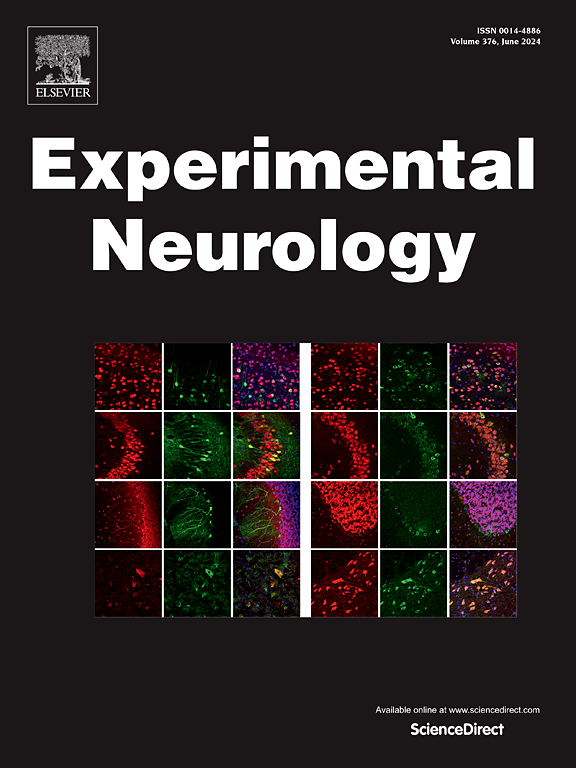结合生物材料支架和神经调控策略,促进啮齿动物脊髓损伤后的组织修复和皮质脊髓连接。
IF 4.6
2区 医学
Q1 NEUROSCIENCES
引用次数: 0
摘要
脊髓损伤(SCI)会对创伤部位造成损害,导致损伤喙侧和尾侧的渐进性和继发性结构缺陷。上升和下降通路的中断会造成运动、感觉和自主神经损伤,因此需要有效的治疗方法。在本研究中,我们在颈椎挫伤 SCI 大鼠模型中采用生物材料与神经调控相结合的策略来修复病变部位并促进降序投射。为促进组织修复,我们使用了壳聚糖片段物理水凝胶悬浮液(Cfphs),这是一种经过优化的生物材料配方,可减轻炎症反应并支持组织重塑。为了促进降序投射,我们以皮质脊髓运动系统为目标,使用运动皮层-跨脊髓直流电神经调控,以促进脊髓损伤喙侧和尾侧幸免的皮质脊髓束(CST)轴突萌发。Cfphs 急性注入病变部位,随后每天进行为期 10 天的神经调控。分析是在 SCI 后 8 周的慢性阶段进行的。与仅使用 SCI 相比,Cfphs 可通过促进损伤部位的组织重塑防止空洞形成,减轻新形成组织周围的星形胶质细胞增生,并使有限的 CST 轴突生长到重塑的损伤部位。单独使用 Cfphs 能明显减少 CST 轴突的衰退,并能保留更多的 CST 轴突灰质投射到 SCI 的喙侧。Cfphs + 神经调控可在损伤喙侧和尾侧产生新芽。我们的研究结果表明,我们的新型生物材料-神经调控组合策略实现了显著的损伤部位组织重塑,并促进了脊髓损伤喙侧和尾侧的CST投射。本文章由计算机程序翻译,如有差异,请以英文原文为准。
Combined biomaterial scaffold and neuromodulation strategy to promote tissue repair and corticospinal connectivity after spinal cord injury in a rodent model
Spinal cord injury (SCI) damages the trauma site, leading to progressive and secondary structural defects rostral and caudal to the injury. Interruption of ascending and descending pathways produce motor, sensory, and autonomic impairments, driving the need for effective therapies. In this study, we address lesion site repair and promoting descending projections using a combined biomaterial-neuromodulation strategy in a rat model of cervical contusion SCI. To promote tissue repair, we used Chitosan fragmented physical hydrogel suspension (Cfphs), a biomaterial formulation optimized to mitigate inflammation and support tissue remodeling. To promote descending projections, we targeted the corticospinal motor system with dual motor cortex–trans-spinal direct current neuromodulation to promote spared corticospinal tract (CST) axon sprouting rostral and caudal to SCI. Cfphs, injected into the lesion site acutely, was followed by 10 days of daily neuromodulation. Analysis was made at the chronic phase, 8-weeks post-SCI. Compared with SCI only, Cfphs alone or in combination with neuromodulation prevented cavity formation, by promoting tissue remodeling at the injury site, abrogated astrogliosis surrounding the newly formed tissue, and enabled limited CST axon growth into the remodeled injury site. Cfphs alone significantly reduced CST axon dieback and was accompanied by preserving more CST axon gray matter projections rostral to SCI. Cfphs + neuromodulation produced sprouting rostral and caudal to injury. Our findings show that our novel biomaterial-neuromodulation combinatorial strategy achieves significant injury site tissue remodeling and promoted CST projections rostral and caudal to SCI.
求助全文
通过发布文献求助,成功后即可免费获取论文全文。
去求助
来源期刊

Experimental Neurology
医学-神经科学
CiteScore
10.10
自引率
3.80%
发文量
258
审稿时长
42 days
期刊介绍:
Experimental Neurology, a Journal of Neuroscience Research, publishes original research in neuroscience with a particular emphasis on novel findings in neural development, regeneration, plasticity and transplantation. The journal has focused on research concerning basic mechanisms underlying neurological disorders.
 求助内容:
求助内容: 应助结果提醒方式:
应助结果提醒方式:


